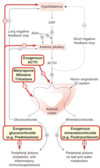Anti-Inflammatory Corticosteroids Flashcards
Effects of Glucocorticoids on Carbohydrate Metabolism
Gluconeogenesis, increase in blood glucose leading to insulin release, and glycogen synthesis with deposition in the liver
Effect of excess glucocorticoids on carbohydrate metabolism
Diabetes-like state
Effect of Glucocorticoids on Protein Metabolism
Increased aminoacid uptake from liver and kidney, decreased protein synthesis (except in liver), result is a net transfer of AAs from muscle/bone to liver
Effect of excess glucocorticoids on protein metabolism
Muscle wasting, catabolism of skin and connective tissue
Effect of Glucocorticoids on Lipid Metabolism
Net effect is lipogenesis due to increased insulin release. There is a greater lipogenic effect in the central tissues.
Effect of excess glucocorticoids on lipid metabolism
Centripetal obesity, buffalo hump and increased abdominal fat.
What is the physiologic mechanism of action of mineralcorticoids?
Aldosterone binds cytosolic receptor, migrates to nucleus where it increased translation of specific proteins: Na-K-ATPase, sodium channels, and potassium channels.
Physiologic effect of mineralcorticoid
Increased reabsorption of sodium from renal distal tubules, and increased secretion of protons and potassium.
What are therapeutic doses of corticosteroids generally used for?
Suppress inflammatory and immune responses. Most useful if the host response is the cause of deleterious effects of the disease.
Anti-Inflammatory effects of glucocorticoids
Decreased production and action of cytokines, reduced generation of leukotrienes and prostaglandins via decreased expression of COX-2 and inhibition of Phospholipase-A2.
Immunosuppressive effects of glucocorticoids
Reduction in chronic inflammation and autoimmune reactions BUT decreased healing and protective aspects of the immune system
How do glucocorticoids enact their immunosuppressive effects?
Suppress T-cell activation, suppress cytokine production, prevent mast cells and eosinophils from releasing chemical mediators
Effects of glucocorticoids on vascular events
Decreased vasodilation, decreased fluid exudation
Effects of glucocorticoids on cellular events
Overall decrease in accumulation and activation of cells
Mineralocorticoid activity refers to…
The salt (Na+)-retaining actions at the kidney.



